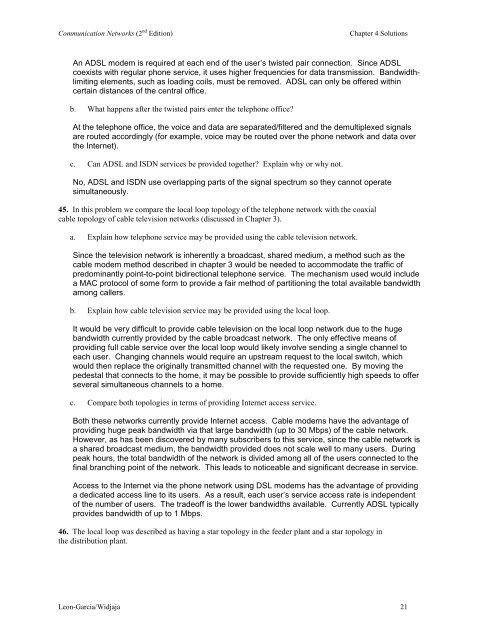Solutions to Chapter 4 - Communication Networks
Solutions to Chapter 4 - Communication Networks
Solutions to Chapter 4 - Communication Networks
Create successful ePaper yourself
Turn your PDF publications into a flip-book with our unique Google optimized e-Paper software.
<strong>Communication</strong> <strong>Networks</strong> (2 nd Edition)<br />
<strong>Chapter</strong> 4 <strong>Solutions</strong><br />
An ADSL modem is required at each end of the user’s twisted pair connection. Since ADSL<br />
coexists with regular phone service, it uses higher frequencies for data transmission. Bandwidthlimiting<br />
elements, such as loading coils, must be removed. ADSL can only be offered within<br />
certain distances of the central office.<br />
b. What happens after the twisted pairs enter the telephone office<br />
At the telephone office, the voice and data are separated/filtered and the demultiplexed signals<br />
are routed accordingly (for example, voice may be routed over the phone network and data over<br />
the Internet).<br />
c. Can ADSL and ISDN services be provided <strong>to</strong>gether Explain why or why not.<br />
No, ADSL and ISDN use overlapping parts of the signal spectrum so they cannot operate<br />
simultaneously.<br />
45. In this problem we compare the local loop <strong>to</strong>pology of the telephone network with the coaxial<br />
cable <strong>to</strong>pology of cable television networks (discussed in <strong>Chapter</strong> 3).<br />
a. Explain how telephone service may be provided using the cable television network.<br />
Since the television network is inherently a broadcast, shared medium, a method such as the<br />
cable modem method described in chapter 3 would be needed <strong>to</strong> accommodate the traffic of<br />
predominantly point-<strong>to</strong>-point bidirectional telephone service. The mechanism used would include<br />
a MAC pro<strong>to</strong>col of some form <strong>to</strong> provide a fair method of partitioning the <strong>to</strong>tal available bandwidth<br />
among callers.<br />
b. Explain how cable television service may be provided using the local loop.<br />
It would be very difficult <strong>to</strong> provide cable television on the local loop network due <strong>to</strong> the huge<br />
bandwidth currently provided by the cable broadcast network. The only effective means of<br />
providing full cable service over the local loop would likely involve sending a single channel <strong>to</strong><br />
each user. Changing channels would require an upstream request <strong>to</strong> the local switch, which<br />
would then replace the originally transmitted channel with the requested one. By moving the<br />
pedestal that connects <strong>to</strong> the home, it may be possible <strong>to</strong> provide sufficiently high speeds <strong>to</strong> offer<br />
several simultaneous channels <strong>to</strong> a home.<br />
c. Compare both <strong>to</strong>pologies in terms of providing Internet access service.<br />
Both these networks currently provide Internet access. Cable modems have the advantage of<br />
providing huge peak bandwidth via that large bandwidth (up <strong>to</strong> 30 Mbps) of the cable network.<br />
However, as has been discovered by many subscribers <strong>to</strong> this service, since the cable network is<br />
a shared broadcast medium, the bandwidth provided does not scale well <strong>to</strong> many users. During<br />
peak hours, the <strong>to</strong>tal bandwidth of the network is divided among all of the users connected <strong>to</strong> the<br />
final branching point of the network. This leads <strong>to</strong> noticeable and significant decrease in service.<br />
Access <strong>to</strong> the Internet via the phone network using DSL modems has the advantage of providing<br />
a dedicated access line <strong>to</strong> its users. As a result, each user’s service access rate is independent<br />
of the number of users. The tradeoff is the lower bandwidths available. Currently ADSL typically<br />
provides bandwidth of up <strong>to</strong> 1 Mbps.<br />
46. The local loop was described as having a star <strong>to</strong>pology in the feeder plant and a star <strong>to</strong>pology in<br />
the distribution plant.<br />
Leon-Garcia/Widjaja 21







